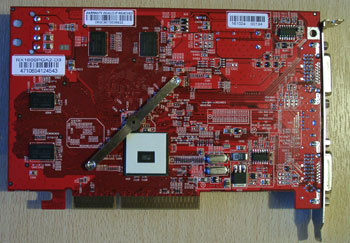GeCube Radeon X1600 PRO AGP
GeCube were the first to announce a Radeon X1000-series product on AGP and they're the first to deliver something that works for our testing at HEXUS. Using ATI's Rialto bridge chip to bring RV530 to AGP in X1600 PRO form, the 256MiB product sits underneath the company's own Radeon X800- and X850-based products that are still available on AGP in terms of pricing.It's somewhat unfair to compair the £100 product to the other GeForce 7800 GS AGP products in this review, but there are certain facets of X1000-series Radeon ownership that make it worth it. Improved AA quality (ATI's adaptive method, similar to NVIDIA's transparency AA) and Shader Model 3.0 support spring to mind immediately. We include it for reference, for those not quite up to dropping £200 on an AGP board. Be aware it's not strict competition to the 7800 GS AGP, because of that.
Clocked at 500/405, the GeCube board beats the ATI reference clocks of 500/340 by 65MHz on the memory. With X1600 PRO a little bandwidth starved at reference clocks, the boost on the memory is welcome. It won't let the board catch the 7800 GSs, but the 5/12/4 config means it's a decent fragment shader at pretty high core clock for a £100 part.
You can clearly see the Rialto bridge chip (surrounded by the white pad on the back side of the board), and if you can't you should click here.
Cooler wise, the Radeon X1600 PRO AGP uses a GeCube variant of a design used by ATI back in the days of Radeon X800. The main heatsink mass is copper and the fan is as quiet as you like, really, so there's no real worries there. A good cooler that's pretty much the equal of that used by the GeForce 7800 GS boards.
We've rounded up a couple more AGP SKUs to go along with the Radeon X1600 PRO AGP as we assess the current AGP landscape, so let's take a look at those and the system used to compare them.











